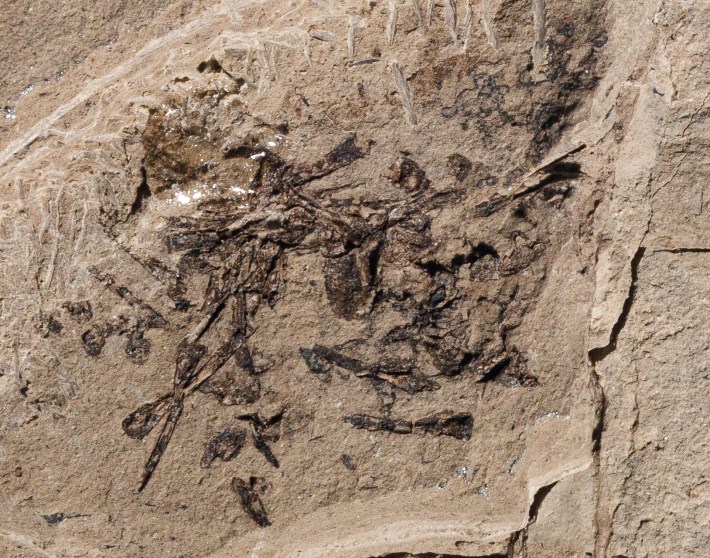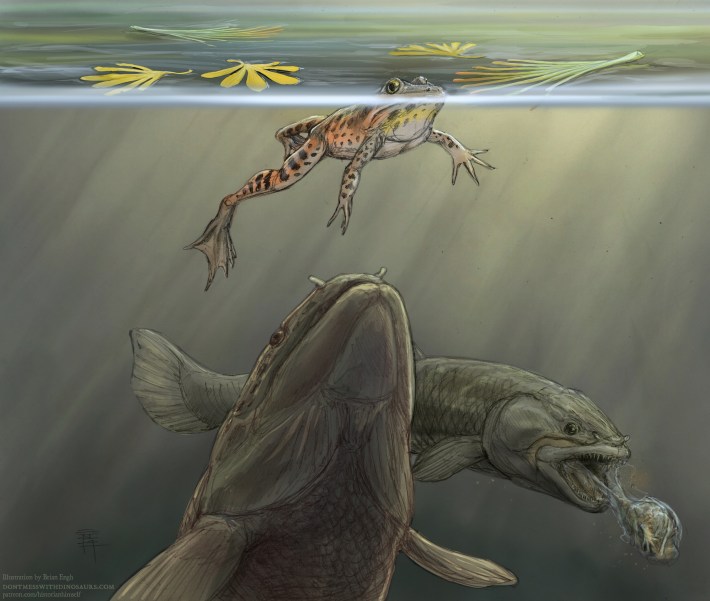The word fossil might conjure the bones of a creature itself—a towering T. rex, a tiny trilobite, an average-sized giant sloth. But life can be immortalized in other, more oblique ways: in the traces an organism leaves behind while going about their life. Some trace fossils are almost poetic. Footprints left behind by a dinosaur or a burrow carved by an ancient worm asks the question: Who left this behind? Other trace fossils are less poetic but even more mysterious. A roundish smattering or small lump of bones raises not one but two questions: Who left this behind, and what from what end did it emerge? In other words: poop or barf?
All fossils require some deciphering, but anything excreted or regurgitated by an animal millions of years ago can be a real enigma. The former, called coprolites, are much more common, and they often look exactly how you might expect expect: nubbly brown lumps. But just as modern poop is a many-splendored thing, ancient excrement can take on many forms. Some squiggly brown fossils that might appear to be unmistakably poop are actually imposters, also called pseudocoprolites. (The Wilkes Formation in southwestern Washington is a trove of such pseudo-poops, formed inorganically when silt and clay filled hollow fragments of wood.)
Even rarer than coprolites are regurgitalites, or fossilized vomit. "It's kind of rare to find direct evidence of who is eating who, or who is vomiting up who, in the fossil record," said Brian Engh, a paleoartist and filmmaker. Although the soft, vegetal barf of an ancient herbivore would have less of a chance of geological immortality, a predator's yakking might at least have some bones in it, according to John Foster, a curator with the Utah Field House of Natural History State Park Museum.
Foster and colleagues described a new fossil regurgitalite in a paper recently published in the journal Palaios. The newly described regurgitalite is tiny—about as long as a staple—but contains the scattered remains of at least two frogs and a fragment of a salamander
When Foster's team first excavated the rock, they thought little of it. They were working in Utah's renowned Morrison Formation, a Late Jurassic site containing hordes of dinosaur bones including the sauropod Diplodocus, whose cruciferous barf would likely not survive the ravages of time. But Foster and colleagues were focused on a lesser-known swath of the Morrison whose abundance of fossilized plants gave it the nickname the "Salad Bar." "There’s a lot to be found in this formation still, and some of it is going to be barf," Engh said.

The researchers brought the specimen back to the museum, where it sat for a year among an assortment of mysteries—"things that we just can't tell what they are," Foster said. Some of these mysteries require two or three turns under a microscope until their identity becomes clear. For example, one of the Salad Bar's mysteries turned out to be a fossil water bug, whose venous wings initially appeared to be the veins of a leaf.
With a microscope, Foster realized what he was looking at was not a plant at all, but a jumble of amphibian bones, some of which were just three millimeters long. And the bones didn't come from just one, tragically disassembled amphibian, but was rather a loose pile of different amphibians. The frogs were tiny—an inch or two long at most. "We knew we had a minimum of two frogs," Foster said. "We found at least a single bone of a salamander."
But then came the real question of the specimen. "To figure out," Foster paused, "whether the thing had been vomited up or pooped out, basically."
There were some visual cues. "Most coprolites that you find are basically little ovals or little tubes or something like that," Foster said. "They retain a kind of three-dimensional character." But the jumble of bones was flat, without the ground mass typical of coprolites, and the stone surrounding it had several laminations—buildups of sediment that probably accumulated each year surrounding the little pile. But to be certain, the researchers had to do a geochemical analysis. An X-ray fluorescence scan of the specimen revealed the specimen did not have elevated levels of phosphorous, which generally indicate a coprolite. The only elevated phosphorous was found in the bones, demonstrating that phosphorous had not been removed from the fossil in the process of turning into a rock.
The specimen has several splotches of a mysterious gray mass, which also did not contain phosphorous. Foster hopes to scan the fossil with a more precise machine at the University of Utah, which would allow him to zero in on specific areas. "It'll be able to give us a pretty good indication of what that unidentified material is," Foster said.
But if the fossil was vomit, who did the vomiting? For now, the culprit's identity is lost to time. The researchers' best guess is a fish, perhaps one similar to a modern bowfin, due to scales they found around the site. Other predators, such as turtles and semiaquatic mammals, are also a possibility, but they haven't been discovered near the site yet, Foster said. Anything larger, like a prehistoric crocodile, would not have bothered chomping on frogs the size of limes. "The barf gives us a window into what else was going on in the ecosystem," Engh said.
Engh, the paleoartist tasked with illustrating what the regurgitalite may have looked like in real life, had a challenge before him. At first, he said, he planned simply to illustrate a fish barfing. "But then all the questions would be about, why is this fish barfing? And also that won't show what the fish was eating." To preemptively answer that question, Engh tried another sketch of a fish being chomped by a crocodilian and barfing defensively—a way of distracting the predator. But without evidence of crocodilians in this corner of the Morrison, that version was scrapped, too.
The final illustration was inspired by the Jaws poster: a bowfin fish approaching the oblivious frog from underneath, ready to chomp. "I realized that I still wanted to show the barfing, so I added another bowfin barfing in the background," Engh said. When Engh's wife, an evolutionary biologist who studies fish, mentioned that lungfish chew by encapsulating whatever they're eating in a glob of mucus and slurp it all in, Engh added a viscous coating of mucus to his regurgitated frog.

The bones inside the regurgitalite were not super fragmented, indicated they may have been only partially digested by the predator. It's possible the predator may have barfed up the swallowed frogs defensively or after digesting frog meat in an attempt to purge the frog bones, Foster said. A mucusy blob would have helped the bones stick together and get preserved, perhaps isolating the bones from scavengers or microbes, he added.
Foster is amazed that the fragile pile of tiny, mostly hollow bones was preserved at all. But his favorite part of the fossil is how it captures the interactions of modern-looking animals that happened to live 150 million years ago. "It kind of helps illustrate how not everything back at the time of the dinosaurs was really weird and wacky," Foster said. "Some of it would have been very familiar to us." If we had been sitting on the shores of this Jurassic pond, we probably would have heard a chorus of frogs, Foster said, and maybe even the distinct, timeless sound of a carnivore upchucking a frog that would chorus no more.






